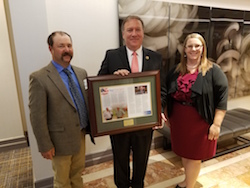The comment period for the proposed renewable volume obligations (RVOs), or the amount of renewable fuels to be blended in the U.S. gasoline supply as required by the Renewable Fuel Standard (RFS) for 2017 came to close on July 11, 2016. While the fuel volumes for first generation biofuels, that includes corn-based ethanol, were slightly higher than for 2016, at 14.8 billion gallons per year, the number is still lower what is required by statue – 15 billion gallons.
 The National Corn Growers Association (NCGA) submitted comments to the U.S. EPA and called on the agency to raise the amount of ethanol blended into the fuel supply. In a letter to EPA Administrator Gina McCarthy, that accompanied their official comments, NCGA President Chip Bowling wrote, “The RFS is doing exactly what it was intended to do. It is successfully driving the adoption of renewable fuel alternatives to petroleum, supporting jobs across the country, and ensuring the United States remains a global leader in developing new renewable energy sources while decreasing GHG emissions here at home.”
The National Corn Growers Association (NCGA) submitted comments to the U.S. EPA and called on the agency to raise the amount of ethanol blended into the fuel supply. In a letter to EPA Administrator Gina McCarthy, that accompanied their official comments, NCGA President Chip Bowling wrote, “The RFS is doing exactly what it was intended to do. It is successfully driving the adoption of renewable fuel alternatives to petroleum, supporting jobs across the country, and ensuring the United States remains a global leader in developing new renewable energy sources while decreasing GHG emissions here at home.”
Bowling continued, “In its Proposed Rule for the 2017 Standards for the Renewable Fuel Standard (RFS) Program, the EPA proposed cutting ethanol volumes below the level set by Congress. This is the fourth consecutive year EPA has proposed volumes below statute, a decision that has stalled investment in the renewable fuels industry…We request that you reconsider the proposed reduction in the renewable volume obligations as a step toward re-establishing regulatory certainty for the renewable fuels industry, and stand up for our nation’s environmental health.”
Comments were also due for the proposed RVOs for the Advanced Biofuels category for 2018 under the RFS and again, the industry is calling for a strengthening of the policy by raising the numbers. The American Soybean Association (ASA) urged EPA to increase the volumes for biomass-based diesel, which includes biodiesel, to 2.5 billion gallons for 2018, an increase of 400 million gallons over the levels in the proposed rule.
 “Our differences with EPA’s proposed volumes are relatively small, but they are important,” wrote ASA President Richard Wilkins in the association’s comments. “The EPA and the Administration are missing an easy opportunity to help the agriculture and rural economy while at the same time achieving greater greenhouse gas emissions reductions – a high priority for EPA and this Administration.”Read More
“Our differences with EPA’s proposed volumes are relatively small, but they are important,” wrote ASA President Richard Wilkins in the association’s comments. “The EPA and the Administration are missing an easy opportunity to help the agriculture and rural economy while at the same time achieving greater greenhouse gas emissions reductions – a high priority for EPA and this Administration.”Read More
 Sometimes you get a pleasant surprise during an IFAJ Congress dinner. That happened during the welcome dinner at this year’s event.
Sometimes you get a pleasant surprise during an IFAJ Congress dinner. That happened during the welcome dinner at this year’s event.










